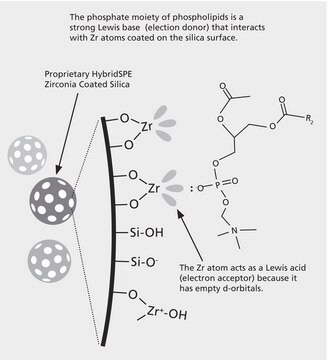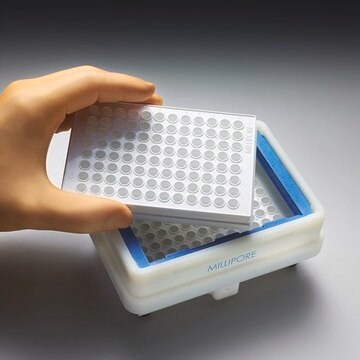52794-U
HybridSPE®-Phospholipid
Small Volume 96-well Plate, bed wt. 15 mg, volume 0.8 mL, pk of 1
About This Item
Niveau de qualité
Gamme de produits
HybridSPE®
Composition
bed wt., 15 mg
Conditionnement
pk of 1
Technique(s)
solid phase extraction (SPE): suitable
Volume
0.8 mL
Groupe de la matrice active
zirconia-based phase
Vous recherchez des produits similaires ? Visite Guide de comparaison des produits
Catégories apparentées
Description générale
The "In-well" and "In-cartridge" precipitation methods are available for the HybridSPE-Phospholipid 96-well version and HybridSPE-Phospholipid Ultra cartridge in which biological plasma/serum is first added to either the well or cartridge, followed by acidified acetonitrile (precipitation agent). After a brief mixing/vortexing step, vacuum is applied. Because the 96-well and Ultra cartridge versions contain a series of low porosity hydrophobic filters/frits, the packed-bed filter/frit assembly acts as a depth filter facilitating the concurrent removal of both phospholipids and precipitated proteins during the extraction process. Standard HybridSPE-Phospholipid cartridges require an "off-line" precipitation method.
Application
- Rapid analysis of 65 pharmaceuticals and 7 personal care products in plasma and whole-body tissue samples of fish using acidic extraction, zirconia-coated silica cleanup, and liquid chromatography-tandem mass spectrometry: This study discusses the advanced application of chromatography and mass spectrometry, which could involve the use of technologies like HybridSPE®-Phospholipid for sample preparation, specifically for rapid analysis in biological matrices (Tanoue et al., 2020).
- Multi LC-MS/MS and LC-HRMS Methods for Determination of 24 Mycotoxins including Major Phase I and II Biomarker Metabolites in Biological Matrices from Pigs and Broiler Chickens: Demonstrates how LC-MS/MS, potentially incorporating HybridSPE®-Phospholipid technology for sample cleanup, facilitates the sensitive and accurate detection of mycotoxins in complex biological samples (Lauwers et al., 2019).
- Evaluation of an Ion Trap Toxtyper Liquid Chromatography With An Ion Trap Mass Spectrometric Instrument (Toxtyper) for Drug of Abuse Screening in Oral Fluid: Explores the utility of specific LC-MS/MS methodologies which could integrate HybridSPE®-Phospholipid for bioanalytical sample cleanup, enhancing drug screening accuracy (Plecko et al., 2018).
- Effective phospholipid removal from plasma samples by solid phase extraction with the use of copper (II) modified silica gel cartridges: This research potentially aligns with the use of HybridSPE®-Phospholipid technologies for phospholipid removal, focusing on enhancing the purity and quality of chromatography samples (Flieger et al., 2017).
- Liquid chromatography mass spectrometry determination of perfluoroalkyl acids in environmental solid extracts after phospholipid removal and on-line turbulent flow chromatography purification: Illustrates a specialized application of chromatography and mass spectrometry where HybridSPE®-Phospholipid could be applied to improve the analysis of environmental samples by efficient phospholipid removal (Mazzoni et al., 2016).
Caractéristiques et avantages
- Merges the simplicity of protein precipitation and the selectivity of SPE via the targeted removal of phospholipids
- Reduce ion-suppression through the complete removal of phospholipids and precipitated proteins
- 2-3 step generic procedure
- Minimal to no method development
- Available in 96-well and 1 mL cartridge dimensions
Informations légales
Produit(s) apparenté(s)
Code de la classe de stockage
11 - Combustible Solids
Classe de danger pour l'eau (WGK)
WGK 3
Point d'éclair (°F)
Not applicable
Point d'éclair (°C)
Not applicable
Choose from one of the most recent versions:
Déjà en possession de ce produit ?
Retrouvez la documentation relative aux produits que vous avez récemment achetés dans la Bibliothèque de documents.
Les clients ont également consulté
Articles
This Sigma-Aldrich article continues to detail new methodology for the analysis of Vitamin D metabolites using HybridSPE-Phospholipid technology.
We are presenting an article focusing on ion-suppression and phospholipid contamination and some of their major causes and difficulties.
This Sigma-Aldrich article discusses how the HybridSPE-Phospholipid Technology works and how the phospholipids are removed.
Protocoles
A simple method to enrich phospholipids from plasma samples, involving a HybridSPE-PPT 96-well plate that both retains phospholipids and removes precipitated proteins.
Notre équipe de scientifiques dispose d'une expérience dans tous les secteurs de la recherche, notamment en sciences de la vie, science des matériaux, synthèse chimique, chromatographie, analyse et dans de nombreux autres domaines..
Contacter notre Service technique
